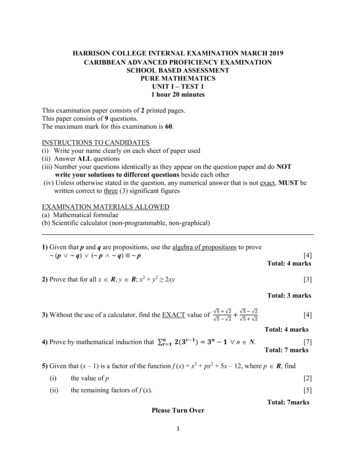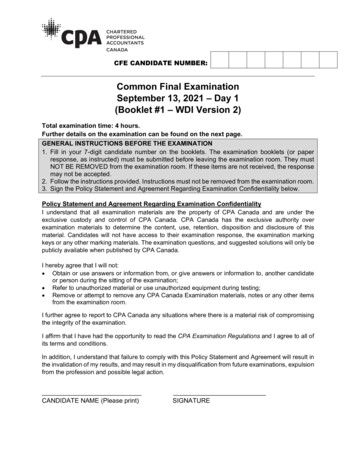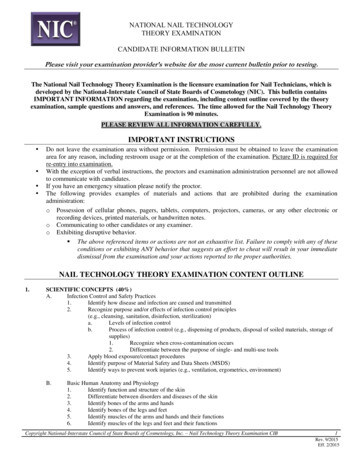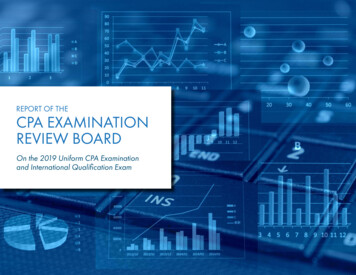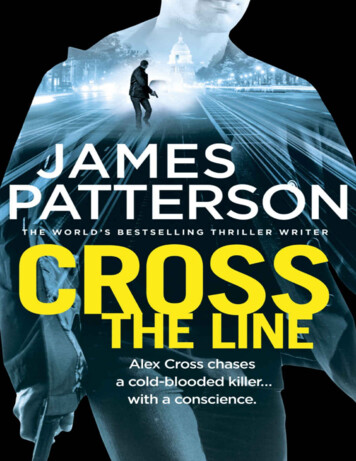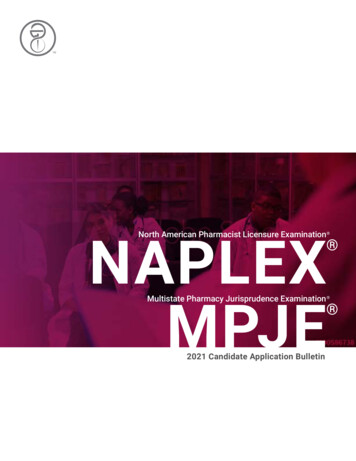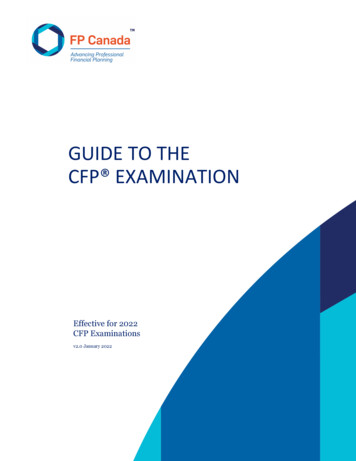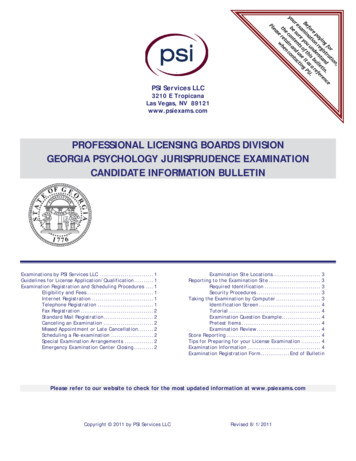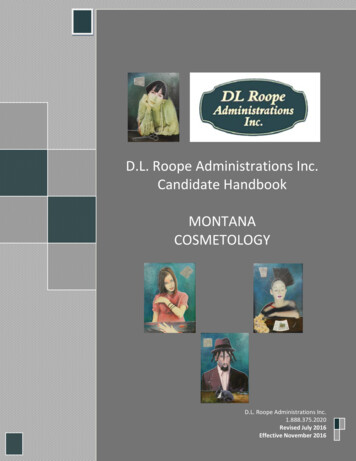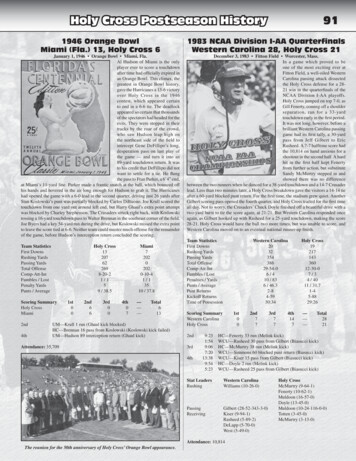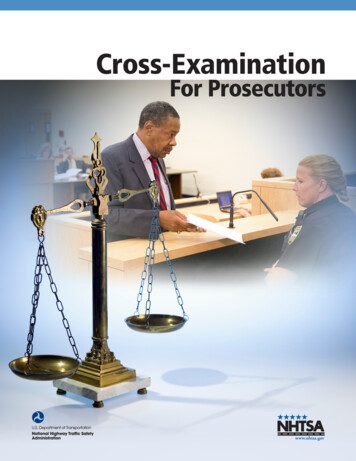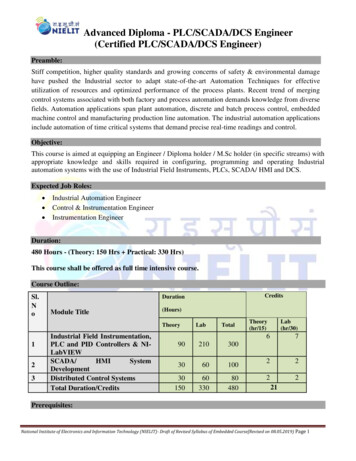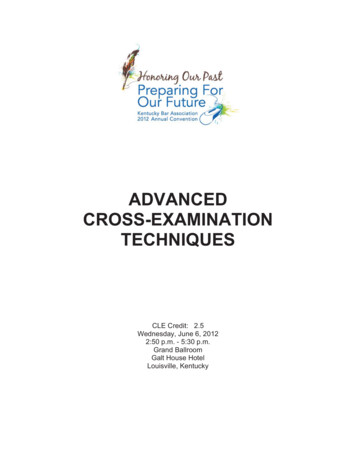
Transcription
ADVANCEDCROSS-EXAMINATIONTECHNIQUESCLE Credit: 2.5Wednesday, June 6, 20122:50 p.m. - 5:30 p.m.Grand BallroomGalt House HotelLouisville, Kentucky1
A NOTE CONCERNING THE PROGRAM MATERIALSThe materials included in this Kentucky Bar Association Continuing LegalEducation handbook are intended to provide current and accurate informationabout the subject matter covered. No representation or warranty is madeconcerning the application of the legal or other principles discussed by theinstructors to any specific fact situation, nor is any prediction made concerninghow any particular judge or jury will interpret or apply such principles. The properinterpretation or application of the principles discussed is a matter for theconsidered judgment of the individual legal practitioner. The faculty and staff ofthis Kentucky Bar Association CLE program disclaim liability therefore. Attorneysusing these materials, or information otherwise conveyed during the program, indealing with a specific legal matter have a duty to research original and currentsources of authority.Printed by: Kanet Pol & Bridges7107 Shona DriveCincinnati, Ohio 45237Kentucky Bar Association2
TABLE OF CONTENTSThe Presenter . iAgenda . 1The Only Three Rules of Cross-Examination. 3The Chapter Method of Cross-Examination . 17Loops, Double Loops and Spontaneous Loops . 31Controlling the Runaway Witness . 393
4
THE PRESENTERRoger J. DoddDodd & Burnham PC613 North Patterson StreetPost Office Box 1066Valdosta, Georgia 31603-1066(229) 242-4470ROGER J. DODD is a Board Certified Criminal Trial Specialist and Civil Trial Specialistand has represented clients in legal matters since 1976. Mr. Dodd has been a lecturer,expert witness, and teacher in all 50 states, the District of Columbia, Russia, St.Thomas, Puerto Rico, Canada, Mexico, and various Caribbean locations. He is afrequent guest and commentator on television programs, including Court TV, GoodMorning America, Geraldo at Large, and is co-author of Cross-Examination: Science andTechniques. He is one of a select group of attorneys to receive the distinguished SuperLawyer rating in multiple states.The majority of Mr. Dodd's practice focuses on serious or catastrophic personal injuries,trucking cases, medical malpractice, aviation accidents, and wrongful death.In 1976, Mr. Dodd received his J.D. from the University of Pittsburgh, School of Law. Heearned his B.A. from Bucknell University in 1973. Mr. Dodd was admitted to practice lawin Georgia in 1976 and in Florida in 1977. He is also admitted to all applicable state andU.S. Courts, the Armed Forces Court of Appeals, and the U.S. Supreme Court. He is anadvocate for the American Board of Trial Advocacy (ABOTA). His present and pastfaculty positions include positions with the National Criminal Defense College (1986present), Georgia Institute of Trial Advocacy (1986-1991), and Advanced CrossExamination — National Criminal Defense College.Mr. Dodd is a member of many organizations, including the National Association ofCriminal Defense Lawyers (NACDL), Georgia Association of Criminal Defense Lawyers(GACDL), Association of Trial Lawyers of America, Georgia Trial Lawyers Association,American Association for Justice, Lawyers Foundation of Georgia, American College ofFamily Trial Lawyers, International Child Abduction Attorney Network, InternationalAcademy of Matrimonial Lawyers, National Board of Legal Specialty Certification, andAmerican Academy of Matrimonial LawyersMr. Dodd is heavily involved in charitable activities, including Kidski and The Boys andGirls Club of Valdosta, and is on the Caregivers Network Leadership Council. He is amember of the Select Advisory Board of Valwood School and has run private trainingcourses for a number of entities, including Wilmer, Cutler & Pickering, the U.S.Department of Justice, Antitrust Division, the U.S. Department of Defense, the AmericanAcademy of Forensic Sciences, and the F.B.I. He is the father of two children.i
ii
ADVANCED CROSS-EXAMINATIONAdapted from the book Cross-Examination: Science and TechniquesLarry S. Pozner and Roger J. Dodd(LEXIS Law Publishing)AGENDATHE ONLY THREE RULES OF CROSS-EXAMINATIONUsing the Power of Leading Questions Forming questions to achieve controlAvoiding the seven enemy wordsTraining witnesses to say, “Yes”Controlling Witnesses One Fact at a Time Shaping jurors’ perceptions of the factUsing simplicity to block escapeFixing the vague questionCreating Goal Oriented Questioning Sequences Encouraging truthful responsesPutting facts into persuasive orderBlocking witness evasionsTHE CHAPTER METHOD OF CROSS-EXAMINATION Breaking cases into understandable partsRecognizing events valuable for cross-examinationPutting facts into your best contextEffect of chapter methods on the opponent’s caseLOOPS, DOUBLE LOOPS, SPONTANEOUS LOOPS How to emphasize your key factsMaking hostile witnesses adopt your descriptionsBeating witnesses with their own wordsCONTROLLING THE RUNAWAY WITNESS Twenty methods of controlling the combative witnessPsychological principles that establish witness controlPunishing the non-responsive answer1
2
THE ONLY THREE RULES OF CROSS-EXAMINATIONLarry S. Pozner and Roger J. DoddAdapted from their book Cross-Examination: Science and Techniques, 2nd Edition1994 , 1995 , 1998 , 2003 , 2004 , 2005 , 2006 , 2007 , 2008 , 2011 Seminar Handout & PowerPoint Presentation Copyrighted 2011 . All rights reserved.These materials are provided for the sole benefit of persons in attendance at this seminar. Noright of reproduction in whole or in part is granted. Larry S. Pozner & Roger J. DoddSYNOPSIS (Sections in Bold are included in the handout in whole or in 26§8.27§8.28§8.29§8.30§8.31§8.32“Great” Cross-Examination: A Misleading TermGreat Cross-Examination TeachesCross-Examiners Control of ThemselvesGreat Cross-Examinations Eliminate DistractionsWhen to say “No Questions on Cross, Your Honor”Relationship of the Three Rules to TimeRelationship of Cross-Examination to Anxiety and ConfidenceReal Time Learning in Cross-ExaminationAchieving Control and Real Time Understanding through the Form of theQuestionThe Historical Context of the Only Three Rules of Cross-ExaminationRule 1: Leading Questions OnlyLeading Questions Allow the Cross-Examiner to Become the TeacherUse Short Declarative QuestionsDeclarative Questions Give Understanding to the JuryDealing with Witnesses Who Don’t Want to AnswerFive Ways to Retrieve AnswersAvoid Enemy Words that Give Control to the WitnessWhat Happens When Those Words are UsedOpen-Ended Questions Encourage Long-Winded Answers Even to LaterLeading QuestionsMood and EmphasisWord Selection, Tone of Voice, Word EmphasisWord SelectionWord Selection Describes TheoryRule 2: One New Fact per QuestionA Time-Honored Method to Teach the Fact FinderVague, Equivocal or Subjective Words do not Count as FactsFixing the Vague QuestionRedefine the Disrupted Issue Using Objective FactsThe More Detail The BetterSubjective InterpretationFaster, Cleaner CrossesThe Three-Step Method to Fix the Equivocal, Vague QuestionTo Order Book, Video Tapes, Audio Tapes or CDs, contact: LexisNexis; Charlottesville, Virginia1-800-446-34103
§8.58§8.59§8.60§8.61§8.62Avoiding the Compound Question Avoids ObjectionsThe “Close Enough” AnswerHow Not to Fix the Bad QuestionNever Abandon the Valid and Necessary Leading QuestionFacts, Not Conclusions, PersuadeConclusions, Opinions, Generalities, and Legalisms Are Not FactsConclusions Are Not FactsOpinions Are Not FactsGeneralities Are Not FactsLegalisms Are Not FactsCreating Impact One Fact at a TimeInfusion of Emotion Question by QuestionWord Selection Made Easier by Envisioning the EventLabelingRule 3: Break Cross-Examination into a Series of Logical Progressionsto Each Specific GoalFrom The Very General to Very Specific GoalsGeneral Questions Lock in and Make Easy the SpecificProceeding from the General Question One Fact at a Time Makes theSpecific Answer InescapableThe General to the Specific Creates InterestThe More Difficult the Witness, The More General The Chapter MustStartChecklist for RulesThe “Yes” Answer is the Most Understood ResponseThe Technique of Seeking a “No” ResponseSeeking the “No” Answer in Order to Marginalize the WitnessMaking Sure to Receive a “Yes” Where “Yes” is Really the Answer“If You Say So” Answer Helpful But Still Requires InterpretationRequiring the Unequivocal Answer for Impeachment and AppealThe Techniques of the Only Three Rules Can Lead to Unexpectedly HonestAnswersSelf Correcting the Cross-Examiner’s Honest MistakesThe Three Rules -- Building Blocks for Advanced Techniques4
SELECTED AND EDITED PORTIONS OF CHAPTER 8 –“THE ONLY THREE RULES OF CROSS-EXAMINATION”§8.1 “Great” Cross-Examination: A Misleading Term (Book page 8-3)The application of techniques discussed in this chapter will dramatically elevate theability of the cross-examiner to obtain favorable admissions, provide support for thetheory of the case, and minimize the ability of the witness to take the cross-examinationinto undesirable areas.The cross-examiner must strive for the consistency of success that comes frompreparation advanced by sound technique. Success in cross-examination is animprecise determination, but can be summarized as the accomplishment of the factualgoals set out by the cross-examiner. Few cross-examinations accomplish every goal, butwith the sound application of techniques, the advocate can expect to accomplish farmore of her goals than would have been accomplished without the application of thescience and techniques of cross-examination.Just as the physicians’ creed begins: “First, do no harm,” the cross-examiner’s creedmust be: “First, do no harm to your client’s case on cross-examination.” There is anelement of risk-taking in every cross-examination. Sound application of techniques canreduce the risks of cross-examination, but never extinguish the risks. One of thehallmarks of great cross-examination is the systematic application of techniquesemployed to establish the greatest amount of helpful information while minimizing therisks inherent in cross-examination.The conventional wisdom is that if a witness has done no damage to the crossexaminer’s case, a lawyer might elect to forgo asking questions. If no questions areasked, certainly the witness can score no additional points. However, even incircumstances where no damage has been done, it may be that the witness could testifyto several additional facts that aid the cross-examiner’s case (see Chapter 11,Sequences of Cross-Examination). Thus, even the witness who has done no damagemay need to be cross-examined. In any event, the skillful cross-examiner views everywitness as an opportunity to introduce testimony that supports the advocate’s theory ofthe case. Simultaneously the cross-examiner seeks to employ techniques designed tominimize the opportunities for the witness to enhance his previous testimony or to openup new areas that will damage the cross-examiner’s positions.§8.2 Great Cross-Examination Teaches (Book page 8-4)Cross-examination is not an exercise based on emotion, presence, and oratory. It is notthe cross-examiner showing the witness and all of those who observe, (but primarily thewitness) that the cross-examiner is smarter, quicker, louder, more demonstrative, ormore fearsome. It is about teaching the cross-examiner’s theory of the case to the factfinder.Cross-examinations are not about a performance by an advocate, but rather theteaching of facts that are critical to the cross-examiner’s theory of the case.Lawyers who believe that cross-examinations are intellectual endeavors rebel againstthe idea of teaching. They want it to be a contest of egos. However, the jury does not5
vote on which lawyer “looks good” or which lawyer performed eloquently. Rather the juryis called upon to vote on a theory of the case. When the lawyer realizes that a crossexamination teaches the cross-examiner’s theory of the case, pressure is reduced. Thefocus is shifted from the cross-examiner’s ego to the cross-examiner’s ability to conveyto the listeners the logic behind the cross-examiner’s theory of the case. Once the focusis shifted from the cross-examiner as lawyer to cross-examiner as teacher, the focusbecomes conveying understandable presentations that guide the fact finder in real time.Problem:Open ended questions seekfacts, but don’t provide facts.Solution:Leading Questions AnswersAnswers FactsFacts Learning§8.3 Cross-Examiners Control of Themselves (Book page 8-4)The system propounded in this text is not based on oratory, flamboyance, demonstrativeabilities, or acting skills. Rather, it is based on simple rules designed to teach the factfinder the theory of the case well. It is also designed to teach the witness that disruptionof the orderly introduction of facts to the jury will receive a negative reaction. Further, itwill teach that the witness complying with the orderly presentation of facts to the jury willreceive positive feedback. The sanctions will be that the witness is forced to verify thetruthful facts sought to be established by the cross-examiner. This process may requireendurance and pain by the witness but it will happen. On the other hand, the witnesswho honestly admits facts that help the cross-examiner’s or hurt the opponent’s theory ofthe case will be rewarded by the cross-examiner moving on to new facts and notpunishing the witness for failure to admit desired facts.§8.7 Relationship of Cross-Examination to Anxiety and Confidence (Book page 87)Each cross-examiner performs better when her confidence is higher. When a crossexaminer is confident, the words come easier. When she is confident, the thoughts comequicker. When she is confident, the goal appears obtainable.Anxiety impedes the processing of information. Anxiety destroys confidence. Anxietyundermines confidence. Anxiety leads to frustration, anger, embarrassment and fear.This goes for witnesses too.6
With the three rules of cross-examination and other techniques in this text, the crossexaminer’s confidence can remain at a high point while the confidence of the witness iseroded and replaced with anxiety. The three rules are designed to keep the lawyer’sconfidence at a high level while keeping the anxiety level of the witness at a high level.Said a different way, the rules are designed to keep the lawyer’s confidence high andher anxiety low, while keeping the anxiety of the witness high and his confidence low.The relationship between the witness and the cross-examiner is an inverse ratio. Whenthe cross-examiner’s confidence is high, the witness’ confidence is low. When the crossexaminer’s anxiety is high, the witness’s anxiety is low. When a witness’s anxiety is highand his confidence is low, he is less likely to carefully select words to explain hisposition. He is less likely to offer additional information to explain his position. He is lesslikely to volunteer new testimony. Ultimately the witness is less likely to tailor histestimony, whether in the obvious form of “lying” or in the less obvious form of carefullyorchestrating his testimony to fit into the theory of the opponent’s case.§8.8 Real Time Learning in Cross-Examination (Book page 8-8)The three rules are designed to permit the fact finder to learn the cross-examiner’stheory of the case and to understand effective attacks upon the opponent’s theory of thecase in real time. Real time is defined as being the instant when the questions andanswers are spoken in trial. The opposite of real time is to suggest that the jury will onlyunderstand the significance of a question and answer in the closing argument, or worse,in the jury room. The jury must understand the significance of the questions and answersat the time of trial. It is only through the building of these facts, one at a time, that thefact finder can appreciate the significance of the testimony and the relationship of thattestimony to other testimony that has come before this witness and will come after thiswitness.The jurors must be able to say to themselves, “I understand why the lawyer is asking thisquestion and I understand the significance of the admission.” Juries vote for what theyunderstand.§8.10 The Historical Context of the Only Three Rules of Cross-Examination (Bookpage 8-9)This chapter sets out the foundation methods of obtaining control of the witness questionby question. There are only three rules. That is something that can be remembered evenin the middle of a cross-examination. The rules are all positive. Something that leads thecross-examiner to understand the rule before it is violated and the damage is done.Finally, the rules apply to every type of case, whether jury trial, a judge trial, anarbitration panel, or mediation. The rules apply in civil cases, criminal cases,administrative cases, and domestic relations cases. Consequently, because the ruleshave universal application, the rules afford the cross-examiner a predictability of result inany kind of setting. Because the rules provide predictable responses, results can bereplicated. The cross-examiner is no longer required to learn a new system of crossexamination when venturing into a different factual setting. The rules are: (1) leadingquestions only, (2) one new fact per question, and (3) a logical progression to onespecific goal.7
§8.11 Rule 1: Leading Questions Only (Book page 8-9)The Federal Rules of Evidence and the rules of evidence of all states, permit leadingquestions on cross-examination (Fed. Rules Evid. Rule 611(c); 28 U.S.C.A.).Simultaneously, the right to use leading questions is almost wholly denied the directexaminer. This is the fundamental distinguishing factor of cross-examination. It is thecritical advantage given the cross-examiner that must always be pressed.Despite this incredible opportunity, many lawyers do not take advantage of this rule andinsist on asking open-ended questions. This is unnecessary at best and foolhardy atworst. A skillful lawyer must never forfeit the enormous advantage offered by the use ofleading questions.The “leading questions only” technique means that, in trial, the cross-examiner mustendeavor to consistently phrase questions that are leading. No matter what the reasonor rationale, a non-leading question introduces far greater dimensions of risk andoccasions far less control than a question that is strictly leading.One of the greatest risks occasioned by the use of open-ended questions is not theanswer that may be given to that question. The answer may be perfectly acceptable tothe cross-examiner. However, by asking the open-ended question the cross-examinerhas failed to consistently train the witness to give short answers to leading questions andnot to volunteer information. By teaching inconsistently, with every open-ended questionthe cross-examiner sows the seeds for later problems in the cross-examination. As willbe discussed, cross-examiner must teach a consistent lesson to the witness: The crossexaminer will pose the question and the witness may verify or deny the suggested fact.The consistency of teaching through the repetitive form of the leading question isfundamental to the goal of witness control.§8.12 Leading Questions Allow the Cross-Examiner to Become the Teacher (Bookpage 8-10)If the lawyer is to teach the case, the lawyer must demonstrate that she understands thecase. The leading question positions the cross-examiner as the teacher, while the openended question positions the cross-examiner as a student. Through the open-endedquestion it is the witness who becomes the teacher. The open-ended question focusescourtroom attention on the witness. The leading question focuses attention on the crossexaminer. The cross-examiner seeks that attention not for ego gratification, but forpurposes of efficiently teaching the facts of the case. The cross-examiner/teacher usingleading questions places the cross-examiner in control of the flow of information. Theleading question also allows the cross-examiner to select the topics to be discussedwithin the cross-examination. These topics will be referred to throughout the book as thechapters of cross-examination.§8.13 Use Short Declarative Questions (Book page 8-10)Leading questions are often defined as questions that suggest the answer. This is toobroad a definition. True leading questions do not merely suggest the answer; theydeclare the answer.8
Leading Questions Answers How do you feel aboutdrinking? Do you like to drink? You like to drink? You drink ?You like it ?§8.14 Declarative Questions Give Understanding to the Jury (Book page 8-11)Juries and judges understand when a leading question is put in a declarative style. Thefact proposed is immediately understandable. It is learnable in real time.Problem:Open ended questions seekfacts, but do not provide facts.Solution:Leading Questions AnswersAnswers FactsFacts Learning23§8.17 Avoid Enemy Words that Give Control to the Witness (Book page 8-14)The adept cross-examiner never uses questions that begin with the following:Enemy Words How Why ExplainWhoWhatWhenWhere25These words create the polar opposite of closed-ended questions. These words inviteuncontrolled, unpredictable, and perhaps unending answers. These words invite thewitness to seize the action, to become the focal point of the courtroom. They take the9
jury’s mind off the fact the cross-examiner is trying to develop and allow the witness toinsert a mishmash of facts, opinions, and stories designed to focus the jury on the issuesthe witness thinks are most important.Cross-examiners are not journalists looking to present both sides of a story. Crossexaminers are not interested in having the witness explain everything that the witnesswishes to explain. Cross-examiners strive to highlight those portions of the witness’stestimony that are helpful to the cross-examiner’s theory of the case.There are those who maintain that they are so skillful that they can pose open-endedquestions, the answers to which will always be of assistance. These lawyers are fond ofsaying, “I didn’t care how she answered,” or “There were no possible answers that couldhurt me.” In response, those lawyers have only eliminated the answers they havethought of. None of us are so omniscient that we can confidently state that we haveeliminated every possible negative answer. There are truly bad answers and nonresponsive answers awaiting the open-ended question. Why take that unnecessarychance? This applies to the most experienced trial lawyer as well as the novice. No oneoutgrows this advice.§8.22 Word Selection (Book page 8-17)One of the most important benefits of the leading question permits the cross-examiner toselect the words to describe the events to be discussed in the question. Most witnessesdo not carefully consider their words nor carefully select words to describe what they aretestifying. Normally, just as in everyday life, the witness offers the best word they canthink of at the time. This may help the opponent’s theory of the case or may be neutral.The one predictable statement that could be made is that the word will not be selected toconsciously help the cross-examiner’s theory of the case.By use of a leading question, the cross-examiner controls the word selection and maymore descriptively and vividly describe that which has occurred.Compare the following two questions:1) You saw a man lying on the side of the road?2) You saw a man hurled from the car?The first question describes with some precision a potential plaintiff in a personal injurysuit. But when compared with the more descriptive word “hurled” in the second question,the first question is colorless.10
Use Vivid Words to Tell StoriesYou saw a man lying on the side of the road?vs. You saw a man hurled from the car?From the VW Bug you smashed into?His body was lying in a heap?On the shoulder of the road?In the dirt?Unconscious?§8.24 Rule 2: One New Fact per Question (Book page 8-19)Cross-examiners need acceptable conclusions supported by facts to work successfully.They need to add only one new fact per question. This is a critical component in thequest for witness control. By placing only a single new fact before a witness, thewitness’s ability to evade is dramatically diminished. Simultaneously, the ability of thefact finder to comprehend the significance of the fact at issue is greatly enhanced.§8.25 A Time-Honored Method to Teach the Fact Finder (Book page 8-19)Your Building ofFactsPersuades andConvincesDr. Seuss, in his classic work Hop on Pop, repeatedly used the smallest component, asingle word, and expanded it only so far as necessary to create a simple sentence:HopPopWe like to hop.We like to hop on top of Pop.Stop. You must not hop on Pop.This teaching method is exactly that necessary to “teach” the witness to answer only“yes.” The jury best learns a case this way, too. Three questions are offered as anexample:1) You threw the ball?11
2) The ball was red?3) You threw the red ball to Sue?The initial question discusses one fact. Each succeeding question contains oneadditional or new fact to be added to the body of facts established by previousquestions.By this method, the scope of the fact at issue is sharply controlled. As a result of the tightcontrol over the scope of the question, the permissible scope of the witness’s answer istightly controlled.§8.33 Avoiding the Compound Question Avoids Objections (Book page 8-25)This method of asking only one fact per question also assists in meeting objections. Asdiscussed, when the cross-examiner asks only one fact per question, she avoids havingto interpret the meaning of a “no” answer. Similarly, when avoiding compoundquestions, counsel sidesteps multi-tiered objections that include objections to the form ofthe question, thus allowing counsel to better meet any forthcoming objection.One New Fact per QuestionSolves Problems No objection Certainty as to answer Easier impeachment Better juror comprehension§8.37 Facts, Not Conclusions, Persuade (Book page 8-28)The second rule of one fact per question tightly controls the witness. The witness hasbefore him but a single new fact. It is hard for the witness to express confusion or beevasive. Moreover the jury is more easily educated by this technique of factualpresentation. Because the facts are so detailed and because the facts are presentedone at a time, the jury will reach the conclusion to which the facts inevitably point. Thejury will embrace the same logical conclusion suggested by the cross-examiner.One might say, the technique of one fact per question is akin to planting acorns in a jurybox, not oak trees. Remember it is the lawyer, not the jury, who is intimately familiar withthe facts. The jury must be slowly and carefully brought to the conclusion sought by theadvocate. It is far safer to let the jury reach its own conclusion based on the facts ratherthan demanding that conclusion from a hostile witness. The structure of one fact perquestion meticulously builds the picture so that the jury reaches the cross-examiner’sdesired conclusion, even though the conclusion itself may never be put to the witness.See chapter 9, The Chapter Method of Cross-Examination and chapter 10, PagePreparation of Cross-Examination.12
§8.45 Word Selection Made Easier by Envisioning the Event (Book page 8-35)While presenting one fact per question, the cross-examiner must make certain that thewords used are adequate to create the desired case scenario. There is a technique toaid the cross-examiner in selecting the descriptive words that can make the pictureclearer and the facts more vivid. If the cross-examiner will form a mental image of whatshe is seeking to describe, and then present that mental image through leadingquestions, the result is a series of leading questions of finer texture. The cross-examinerwishes the fact finder to see the picture, so it would only stand to reason that the crossexaminer must first see that picture.The cross-examiner must strive to use descriptive words to describe accurately the factsquestioned upon. The descriptive words will come naturally to mind when the crossexaminer will look into her own head to see the event.§8.46 Labeling (Book page 8-35)In this age where more and more information floods our senses daily, jurors and judgesfind it difficult to remember names and events. Word selection is critical in labeling allmajor witnesses, all major pieces of evidence, and all major events within the theory ofthe cross-examiner’s case. In the example above, Jim is labeled “the big boy” and Daveis labeled the “little boy”. The action is labeled a “beating” (beat on). These are fair,reasonable descriptions of what happened that vividly illustrate the cross-examiner’stheory of the case. For more on labeling, see chapter 26, Loops, Double Loops, andSpontaneous Loops.§8.47 Rule 3: Break Cross-Examination into a Series of Logical Progressions toEach Specific Goal (Book page 8-35)Cross-examination of a witness is not a monolithic exercise. Instead, the crossexamination of any witness is a series of goal-oriented exercises. The third techn
Dodd & Burnham PC 613 North Patterson Street Post Office Box 1066 . Mr. Dodd was admitted to practice law in Georgia in 1976 and in Florida in 1977. He is also admitted to all applicable state and U.S. Courts, the Armed Forces Court of Appeals, and the U.S. Supreme Court. He is an advocate for the American Board of Trial Advocacy (ABOTA). His present and past faculty positions include .
